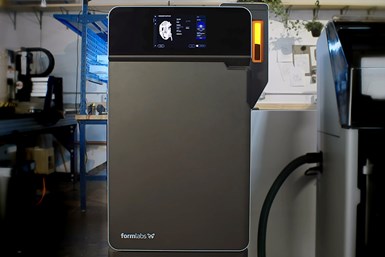Formlabs Launches PreForm Software for Improved Packing Densities
The software is designed to improve packing density, resulting in less leftover powder with each 3D print and a lower cost per part.

Formlabs’ Fuse 1 SLS printer is designed to expand access to production-ready 3D printing. Photo Credit: Formlabs
Formlabs’ PreForm software was developed to enable printing production-ready parts and highly functional prototypes at a more efficient rate and lower cost. The company says its Fuse 1 printer provides affordable access to high quality selective laser sintering (SLS) printing technology, with the free PreForm software designed to improve packing density for less leftover powder with each print and a lower cost per part.
Fuse 1 users can give the packing algorithm full control of model orientations or lock orientations of models before packing. The feature also gives the option to pack only specific models while keeping others locked in place. Using the PreForm software, the highest packing density possible on the Fuse 1 helps users achieve high throughput and increase material efficiency to fill as much build volume as possible with printed parts, the company says.
Formlabs says its internal teams’ initial testing indicates the PreForm 3D packing algorithm collectively reduced the cost of prints run during that time by 29%. The packing algorithm is also said to reduce the preparation time for Fuse 1 print jobs by 73%, which saved Formlabs’ Berlin-based print farm three hours of work time, daily.
According to the company, the algorithm was developed and tested against thousands of print jobs and in simulated prints, with results indicating it’s competitive with other leading 3D packing software solutions.
The updated 3D packing function is available for all Fuse 1 customers. The free PreForm 3.20.0 update includes a completely redesigned 3D packing algorithm built to achieve the highest packing density possible on the Fuse 1.
Related Content
-
Decentralized Manufacturing Network Aims to Make 3D Printers a Shared Global Resource
The 3DOS additive manufacturing network will let OEMs and creators take advantage of open 3D printer capacity anywhere in the world.
-
3D Printed "Evolved Structures" for NASA Exoplanet Balloon Mission: The Cool Parts Show #61
Generative design creates stiff, lightweight brackets for EXCITE mission monitoring planets orbiting other stars. The Cool Parts Show visits Goddard Space Flight Center.
-
3D Printed Cutting Tool for Large Transmission Part: The Cool Parts Show Bonus
A boring tool that was once 30 kg challenged the performance of the machining center using it. The replacement tool is 11.5 kg, and more efficient as well, thanks to generative design.







.jpg;maxWidth=300;quality=90)





